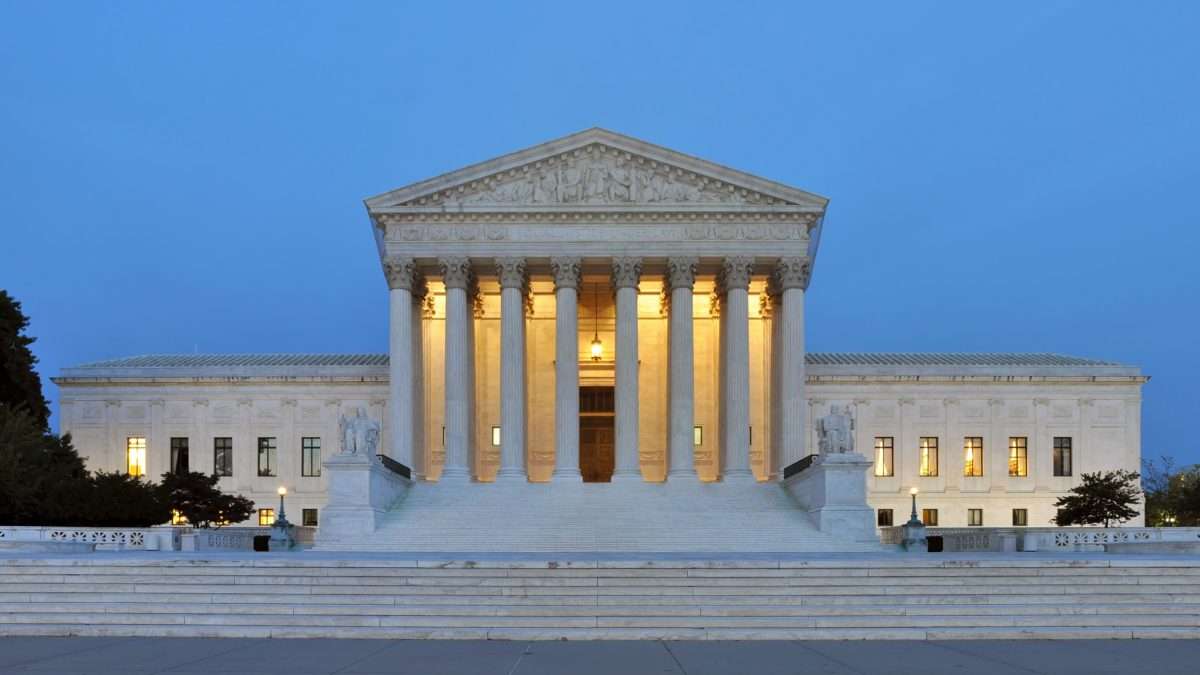The Supreme Court's Dubious Use of History in Department of State v. Munoz


In its important recent immigration decision in Department of State v. Munoz, the Supreme Court ruled there are virtually no constitutional limits on the federal government's power to bar non-citizen spouses of American citizens from entering the country. In the process, Justice Amy Coney Barrett's majority opinion (written on behalf of herself and the five other conservative justices) commits serious errors in historical analysis, and violates Justice Barrett's own well-taken strictures about the appropriate use of history in constitutional analysis.
Sandra Munoz is a US citizen whose husband, Luis Asencio-Cordero (a citizen of El Salvador) was barred from entering the US to come live with her, because US consular officials claimed he had ties to the MS-13 criminal drug gang (which connectoin Ascencio-Cordero denies). Munoz filed suit, claiming that, given that the constitutional right to marriage was implicated, the State Department was at the very least required to reveal the evidence that supposedly proved her husband's connection to the gang.
In arguing that there is no originalist or historical justification for US citizens to claim a right to entry for their non-citizen spouses, Justice Barrett cites historical evidence from the 1790s:
From the beginning, the admission of noncitizens into the country was characterized as "of favor [and] not of right." J. Madison, Report of 1800 (Jan. 7, 1800)…. (emphasis added); see also 2 Records of the Federal Convention of 1787, p. 238 (M. Farrand ed. 1911) (recounting Gouverneur Morris's observation that "every Society from a great nation down to a club ha[s] the right of declaring the conditions on which new members should be admitted"); Debate on Virginia Resolutions, in The Virginia Report of 1799–1800, p. 31 (1850) ("[B]y the law of nations, it is left in the power of all states to take such measures about the admission of strangers as they think convenient"). Consistent with this view, the 1798 Act Concerning Aliens gave the President complete discretion to remove "all such aliens as he shall judge dangerous to the peace and safety of the United States." 1 Stat. 571 (emphasis deleted). The Act made no exception for spouses—or, for that matter, other family members.
Almost everything in this passage is either false or misleading. The quote from James Madison's Report of 1800, does not, in fact, indicate that Madison believed the federal government has blanket authority to exclude immigrants for whatever reason it wants. Far from it. Madison was arguing that the Alien Friends Act of 1798 (part of the notorious Alien and Sedition Acts) was unconstitutional because the federal government lacks such power. Here is the passage where the quote occurs:
One argument offered in justification of this power exercised over aliens, is, that the admission of them into the country being of favor not of right, the favor is at all times revokable.
To this argument it might be answered, that allowing the truth of the inference, it would be no proof of what is required. A question would still occur, whether the constitution had vested the discretionary power of admitting aliens in the federal government or in the state governments.
Note that Madison does not even admit that admission of immigrants is "a favor." He just assumes it is for the sake of argument, then goes on to argue that the Alien Act is unconstitutional regardless, because the relevant power isn't given to the federal government (this is what he argues in the rest of the Alien Act section of his Report). The 1798 Act Concerning Aliens, also quoted by Justice Barrett, is the very same Alien Friends Act denounced as unconstitutional by Madison, Thomas Jefferson, and many others. Opposition to the Act was so widespread that no one was ever actually deported under it, before Thomas Jefferson allowed it to expire upon becoming president in 1801.
I think Jefferson and Madison were right to argue the Alien Friends Act was unconstitutional. But, at the very least, legislation whose constitutionality was so widely questioned at the time cannot be relied on as strong evidence of the original scope of federal power in this area.
The quote by Gouverneur Morris at the Constitutional Convention is not about immigration restrictions at all. It is part of a speech defending his proposal that people must be required to have been citizens for at least fourteen years before being eligible to become US senators. The proposal was rejected by the Convention (which eventually decided on a nine-year requirement). It was denounced by several other prominent members of the Convention, including James Madison and Benjamin Franklin. Madison argued it was "unnecessary, and improper" and would "give a tincture of illiberality to the Constitution" (see Records of the Federal Convention of 1787, Vol. 2, pp. 235-37 (Max Farrand, ed., 1911)).
Morris's speech in favor of this failed proposal is not a reliable guide to the sentiments of the Convention. Still less is it indicative of the original meaning understood by the general public at the time of ratification (which is the relevant criterion for most originalists, including Justice Barrett, who has said the original meaning of a constitutional provision is "the meaning that it had at the time people ratified it").
Finally, the Debate on the Virginia Resolutions in the Virginia Report of 1799-1800, also quoted by Justice Barrett, was a record of debates in the Virginia state legislature over the Virginia Resolution (drafted by Madison) a statement asserting that the Alien Friends Act is unconstitutional. The passage Barrett quotes is from a speech by a dissenting member of the Virginia state legislature opposing the Resolution. The majority, however, sided with Madison.
Given this history, the debate over the Resolution cannot be relied on to justify virtually unlimited federal power over immigration by spouses of citizens, or any other migrants. And because Madison and the majority in the state legislature argued that the entire Alien Friends Act was unconstitutional, they understandably did not bother to argue that there was a separate issue regarding exclusion of non-citizen spouses of citizens. To my knowledge, no such case involving spouses came up during the short time the Act was in force.
Justice Barrett also relies on dubious 19th century history:
The United States had relatively open borders until the late 19th century. But once Congress began to restrict immigration, "it enacted a complicated web of regulations
that erected serious impediments to a person's ability to bring a spouse into the United States." Din, 576 U. S., at 96 (plurality opinion). One of the first federal immigration
statutes, the Immigration Act of 1882, required executive officials to "examine" noncitizens and deny "permi[ssion] to land" to "any convict, lunatic, idiot, or any person unable to take care of himself or herself without becoming a public charge." 22 Stat. 214. The Act provided no exception for citizens' spouses. And when Congress drafted a successor statute that expanded the grounds of inadmissibility, it again gave no special treatment to the marital relationship….
This legislation was enacted almost a century after the Founding. So its relevance to original meaning is highly questionable, at best. Moreover, it was adopted in an era of widspread nativist and racist hostility to Chinese immigration, at a time when the Supreme Court also upheld a wide range of domestic racially discriminatory legislation, as well. The Immigration Act of 1882 was enacted by the same Congress and in the same year as the deeply racist Chinese Exclusion Act. The latter legislation was upheld by the Supreme Court in a terrible 1889 decision that completely ignored the arguments Madison and other Founders had raised against a broad federal power over immigration. The immigration policies and legal decisions of this era were part and parcel of the same mentality that also led to Plessy v. Ferguson.
In her recent concurring opinion in United States v. Rahimi, an important Second Amendment case, Justice Barrett warned about careless reliance on post-ratification history in constitutional interpretation:
[F]or an originalist, the history that matters most is the history surrounding the ratification of the text; that backdrop illuminates the meaning of the enacted law. History (or tradition) that long postdates ratification does not serve that function. To be
sure, postenactment history can be an important tool. For example, it can "reinforce our understanding of the Constitution's original meaning"; "liquidate ambiguous constitutional provisions"; provide persuasive evidence of the original meaning; and, if stare decisis applies, control the outcome…. But generally speaking, the use of postenactment history requires some justification other than originalism simpliciter….As I have explained elsewhere, evidence of "tradition" unmoored from original meaning is not binding law… And scattered cases or regulations pulled from history may have little bearing on the meaning of the text.
Here, Barrett relies heavily on "evidence of 'tradition' unmoored from original meaning" and "scattered… regulations" enacted more than a century after ratification. In fairness, the nineteenth century laws in question were enacted closer in time to the ratification of the Fourteenth Amendment in 1868, which is where the Supreme Court has said the right to marry arises from (albeit, when it comes to the federal government, the right is read back into the Fifth Amendment). But the 1880s was still a long time after ratification. Moreover, the laws in question were enacted at a time when racial and ethnic bigotry undermined enforcement of much of the original meaning of the Fourteenth Amendment, and such bigotry heavily influenced immigration legislation and jurisprudence.
Barrett also relies on the history in part because the Supreme Court's test for whether the Due Process Clauses of the Fifth and Fourteenth Amendment protect an unenumerated right (like right to marry) require the right to be "deeply rooted in this Nation's history and tradition." But a combination of badly misinterpreted 1790s history and 19th century history heavily tinged by racial and ethnic bigotry are poor means for applying that test.
As Justice Barrett recognizes later in her opinion, in later years Congress did in fact enact legislation giving spouses of US citizens a presumptive right to enter the United States, though there are exceptions, such as the one for "unlawful activities" at issue in this case. That suggests there may in fact be a historically rooted right to spousal migration, even if not an absolute one (most other constitutional rights aren't completely absolute, either).
Overall, I think Amy Coney Barrett has been a pretty good justice since her controversial appointment just before the 2020 election. But Munoz is far from her finest hour.
The Court's badly flawed handling of history doesn't necessarily mean the bottom-line decision was wrong. Even the dissenting liberal justices agreed the government was justified in denying Asencio-Cordero a visa, reasoning that the possible ties to MS-13 were a sufficient justification to outweigh the right to marry in an immigration case (and, as Justice Gorsuch notes in a concurring opinion, the government did eventually reveal the evidence in question). Alternatively, one can argue the right to marriage doesn't necessarily include a broad right to have your spouse present in the same jurisdiction. There may be other possible justifications for the outcome, as well.
But the Supreme Court should not have relied on a badly flawed interpretation of post-enactment history to justify a sweeping power to run roughshod over marriage rights in immigration cases, even in situations where the right to marry might otherwise impose a constraint. That's especially true given that similar reasoning could potentially be used to apply to other constitutional rights. If the Alien Friends Act of 1798 and 1880s immigration legislation qualify as relevant evidence, they could be used to justify almost any immigration restriction.
Obviously, Munoz is far from the first Supreme Court decision where the justices effectively exempted immigration restrictions from constitutional constraints that apply to other federal laws. Trump v. Hawaii, the 2018 travel ban decision is another recent example, and there are other such cases going back to the 19th century. But Munoz is still notable for its particularly slipshod historical analysis.
The post The Supreme Court's Dubious Use of History in Department of State v. Munoz appeared first on Reason.com.




